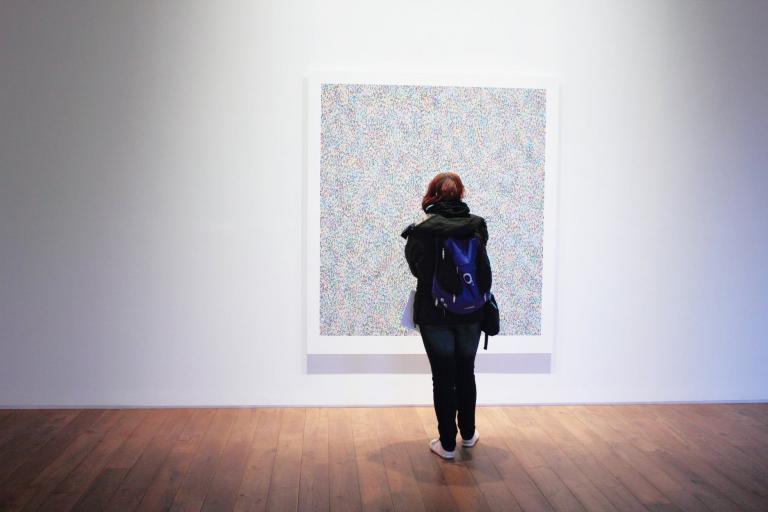
“Why are so many artists progressives?” my dear friends who blog under Darwin Catholic asked a while ago. Adding the usual follow-up question:
“Where have all the Catholic artists gone?”
It’s a good question, and one that’s brought up every few months or so, along with the corollary question of: “So, what is Catholic art anyway?”
Mr. Darwin’s question spurred a lengthy and fruitful Facebook thread, with several Catholic non-artists postulating a lot about What Sort Of Person would become one of those Scandalous Artists(!), while my answer – upon reflection of my own nearly 30 years as a working artist – was simply:
You Get The Art You Pay For
Let me ‘splain.
I’ve been a working playwright since 1992, when I was a high school summer camp counselor. About a week in, the staff was told that we had to put on about a half hour sketch show at the end of the season for the elementary school kids. While my fellow counselors – all older, mostly jocks, way more popular than me – started complaining and brainstorming about old scout skits they’d done, I stopped the conversation saying:
EMILY. No! Nope, no no no. If I do one more utterly inane scout skit, I’m going to explode. This is what we’re going to do. I’ll write us a play. We’ll act it out. I’ll tell you what to do. Any objections? No? No, I didn’t think so. I’ll have the script in a week. DONE.
Everyone else, who didn’t want to do anything anyway, agreed to let me boss them around. (I later found out this is called “Directing” and you can major in it.)
Because this was going to be a skit for kids, naturally I wrote a fractured fairy tale about Cinderella, called Shattered Glass which, as I recall, used Weird Al’s “Smells Like Nirvana” for the ballroom scene. (I was nothing if not topical.)
Needless to say, I knew my territory. The play was a success. And for the following two years, I simply wrote us a fractured fairy tale, directed in it, and sometimes took a minor role.
But here’s the important thing:
I didn’t want to write a fractured fairy tale.
Or rather, it wasn’t so much that I, as an artist, was dying to write the Fractured Fairy Tale Masterpiece To Out Grimm Grimms! Rather, that’s what this audience was buying. So that became what this artist was selling. If our bosses had nixed the Cinderella idea, and told us we had to do skits about, oh, campfires or something, you can bet your bare bodkin I’d have written about campfires.
You get the art you pay for.
Where Have All The Patrons Gone?
When people ask: “Where have all the Catholic artists gone?” I frequently want to shoot back, “Where have all the patrons gone?”
Artists, just like all humans, have to eat. But art, unlike most professions, is an activity that more than just professionals can partake in – hence, it tends to pay less. (Which is my working theory about why we pay teachers – surrogate parents – too little, too. Well, that and the perversity of human nature.)
Amateur artists – literally, lover of the arts – no matter how talented they may be, only partake in their art so long as it remains pleasing. The community theatre actor will drop out as soon as it’s no longer fun.
Compare this to professional artists – literally, one who fulfills their vow to the arts – who will stick through the terrible rehearsal process and the bad reviews and the starving (literally, I do mean literally starving – we all have our “tomato soup out of stolen ketchup packets months”), and the constant travel, and the early mornings and late nights, and everything besides because art is not only our job, it’s our vocation. It’s what we must do.
And must somehow survive to do again tomorrow.
Thus, as a working artist, I simply don’t have the luxury of only working on those projects which interest me. (Ahem. Fantasy novels in this universe. Ahem.)
Rather, I take the gigs I’m offered. Back in Massachusetts, this meant a lot more fractured fairy tales, and story adaptations, and the occasional school-themed piece (see below) – everything pretty PG, since those were family audiences.
And parents were my patrons.
It meant directing a lot of musicals – some of them twice (Guys and Dolls twice) – and even more Shakespeare since we could do him for free – some of Shakespeare twice (A Midsummer Night’s Dream twice). And insofar as I had choice, and I did, it was still within the realm of what my patrons would buy.
For example: one summer, I directed Much Ado About Nothing and it was a flop. I realized that it wasn’t that my patrons wanted to see just any Shakespeare. They wanted to see Shakespeare they already knew. The following year I did Romeo and Juliet and we had a hit.
You get the art you pay for.
Patronize Crap, Get More Crap
As mentioned before, many of my fellow Catholics and bloggers were shocked, I tell you, shocked(!) to discover the existence of the Met Gala. How could Catholics allow in such terrible sartorial costumes? How dare secular artists look at the Catholic church and riff on the baroque masterpieces? How dare they! “Cultural appropriation!”
Of course, a few people joked, perhaps we would have been less scandalized if someone had worn a felt banner with a poorly drawn dove ironed on. After all, that’s “Catholic art,” too, right? Well, unfortunately: yes. It’s also crap. And I, for one, am glad that no one at the Metropolitan Museum of Art bought that.
But how do we get crap art?
The PureFlix and the felt banners and the chunky stained glass, not to mention Fuller House and Roseanne revived and Mean Girls: The Musical and for that matter, Spongebob: The Musical (although people apparently like that) – and even “good” crap art like the infinite Marvel movies and a million Star Wars movies, and the Simpsons stopped being groundbreaking twenty years ago.
How do we get crap?
Well, you get the art you pay for.
People will pay for properties they already know. Christians will pay for crummy art, so long as the advertising promises that it will be “nice.” Not good. Just nice. And don’t forget the vanity projects by people with no talent and too much money. Here in town, I’ve directed quite a few of those.
Why? Because it’s good? No. Because it paid.
You get the art you pay for.
Become A Patron, Change The World
Here’s the good news, though: it’s possible to change the world. It’s possible to get good, even great art. It’s possible, in fact, to usher in an American Renaissance. And it doesn’t take much to do it at all.
Take a look at some of the artwork of the Western world: the Sistine Chapel, Shakespeare, Mozart’s Requiem, even that “Heavenly Bodies” exhibit. Each one of them were paid, commissioned – and the content dictated.
Michaelangelo might have preferred to finish his non-finito statues, but he was paid to paint the Vatican. Shakespeare famously wrote The Merry Wives of Windsor in two weeks because Queen Elizabeth wanted to see Falstaff in love – while apparently his Troilus and Cressida was such a flop, he never wrote the sequel. (Although he put a speech of it in a little play called Hamlet.) Mozart literally killed himself writing his own Requiem. And if you ever see his Magic Flute, just realize that it’s a freaking weird plot because it was commissioned by the Masons.
So it goes for every masterpiece that’s detailed in Magnificat. Someone paid for a Madonna and child. And you can, too. In fact, you already do.
Consider this: every time you buy a movie ticket, you’re a patron. Every time you see your kids’ play, you’ve allowed the director to survive. Each monthly payment to Spotify goes, in ridiculously small part, to the musicians you listen to on repeat.
You are already a patron. Now, become a direct patron.
I want to point your attention to two places: Patreon and the Catholic Artist Connection.
Patreon: Is a new platform that allows you to be a direct patron of the arts immediately to the artist. I support two of my favorite vloggers, paying $2/month to each, and I value the content they put out. And there are those who support me on Patreon, (in fact, we’re just $27 away from ensuring two Pop Feminist blogs a week!)
If you really want to encourage certain content, I urge you to poke around Patreon and to get involved. Give feedback. Tell artists what you like and why – and believe you me, we’ll respond. For example, I don’t always answer comments here (well, they’ve gone…weird), but I definitely hurried out my Avengers: Infinity War review because of interaction with my patrons over on my Facebook page.
Catholic Artist Connection: If you’re an artist, or if you know an artist, point them towards the Catholic Artist Connection, which is a weekly newsletter full of opportunities in every discipline. For those in the NYC area, take a look at Catholic Artists NYC, which is full of residencies, companies, and other artists in your field.
If you want to be a patron of the arts, take a look at this site, too, and see how you can donate. You can support anyone from individual artists to larger organizations like The Sheen Center, which is producing Catholic playwrights. (Including a reading of my Merry Widows of Windsor! – which itself was only written in an attempt to be bought by the American Shakespeare Center. You get the art you pay for.)
Look locally as well. Go to that play, that concert, that movie. Buy that book. Commission that charcoal sketch. Buy from that Etsy store.
This is how you change the world.
Don’t just settle for the art that exists.
Get the art you pay for.
 Image courtesy of Pexels.
Image courtesy of Pexels.
Now that you know what it is, become my patron on Patreon!












